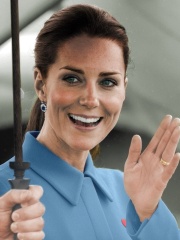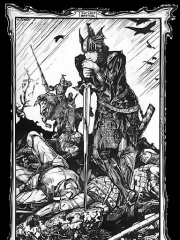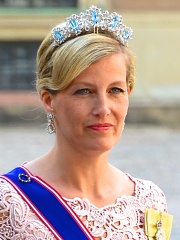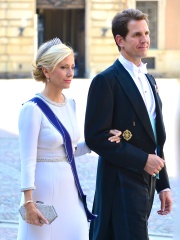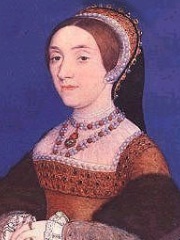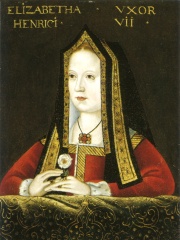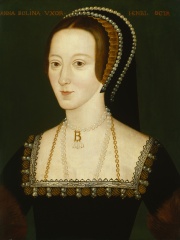
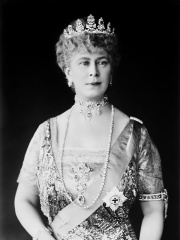
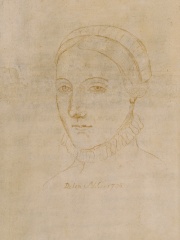
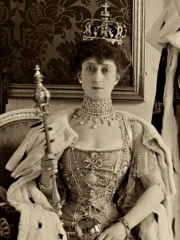
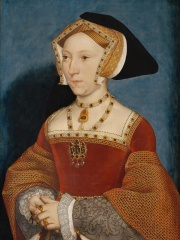
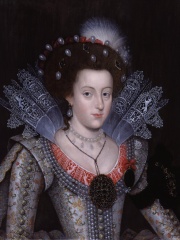
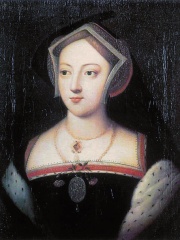
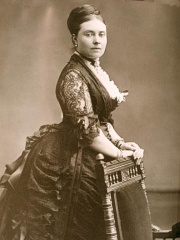
The Most Famous
COMPANIONS from United Kingdom
This page contains a list of the greatest British Companions. The pantheon dataset contains 784 Companions, 62 of which were born in United Kingdom. This makes United Kingdom the birth place of the 3rd most number of Companions behind Germany, and France.
Top 10
The following people are considered by Pantheon to be the top 10 most legendary British Companions of all time. This list of famous British Companions is sorted by HPI (Historical Popularity Index), a metric that aggregates information on a biography's online popularity. Visit the rankings page to view the entire list of British Companions.

1. Anne Boleyn (1501 - 1536)
With an HPI of 86.36, Anne Boleyn is the most famous British Companion. Her biography has been translated into 90 different languages on wikipedia.
Anne Boleyn (; c. 1501 or 1507 – 19 May 1536) was Queen of England from 1533 to 1536, as the second wife of King Henry VIII. The circumstances of her marriage and execution, by beheading for treason, made her a key figure in the political and religious upheaval that marked the start of the English Reformation. Anne was the daughter of Thomas Boleyn (later Earl of Wiltshire), and his wife, Elizabeth Howard, and was educated in the Netherlands and France. Anne returned to England in early 1522, to marry her cousin James Butler, 9th Earl of Ormond; the marriage plans were broken off, and instead, she secured a post at court as maid of honour to Henry VIII's wife, Catherine of Aragon. Early in 1523, Anne was secretly betrothed to Henry Percy, son of Henry Percy, 5th Earl of Northumberland, but the betrothal was broken off when the Earl refused to support it. Cardinal Thomas Wolsey refused the match in January 1524. In February or March 1526, Henry VIII began his pursuit of Anne. She resisted his attempts to seduce her, refusing to become his mistress, as her sister Mary had previously been. Henry focused on annulling his marriage to Catherine, so he would be free to marry Anne. After Wolsey failed to obtain an annulment from Pope Clement VII, it became clear the marriage would not be annulled by the Catholic Church. As a result, Henry and his advisers, such as Thomas Cromwell, began breaking the Church's power in England and closing the monasteries. Henry and Anne formally married on 25 January 1533, after a secret wedding on 14 November 1532. On 23 May 1533, the newly appointed Archbishop of Canterbury Thomas Cranmer declared Henry and Catherine's marriage null and void. Five days later, he declared Henry and Anne's marriage valid. Clement excommunicated Henry and Cranmer. As a result of the marriage and excommunications, the first break between the Church of England and the Catholic Church took place, and the King took control of the Church of England. Anne was crowned queen on 1 June 1533. On 7 September, she gave birth to the future Queen Elizabeth I. Henry was disappointed to have a daughter, but hoped a son would follow and professed to love Elizabeth. Anne subsequently had three miscarriages and by March 1536, Henry was courting Jane Seymour. Henry had Anne investigated for high treason in April 1536. On 2 May, she was arrested and sent to the Tower of London, where she was tried before a jury, including Henry Percy, her former betrothed, and her uncle Thomas Howard, 3rd Duke of Norfolk. She was convicted on 15 May and beheaded four days later. Historians view the charges, which included adultery, incest with her brother George, and plotting to kill the King, as unconvincing. After her daughter, Elizabeth, became queen in 1558, Anne became venerated as a martyr and heroine of the English Reformation, particularly through the works of George Wyatt. She has inspired, or been mentioned in, many cultural works and retained her hold on the popular imagination. She has been called "the most influential and important queen consort England has ever had", as she provided the occasion for Henry to declare the English Church's independence from the Vatican.

2. Mary of Teck (1867 - 1953)
With an HPI of 83.82, Mary of Teck is the 2nd most famous British Companion. Her biography has been translated into 53 different languages.
Mary of Teck (Victoria Mary Augusta Louise Olga Pauline Claudine Agnes; 26 May 1867 – 24 March 1953) was Queen of the United Kingdom and the British Dominions, and Empress of India, from 6 May 1910 until 20 January 1936 as the wife of King George V. Born and raised in London, Mary was the daughter of Francis, Duke of Teck, a German nobleman, and Princess Mary Adelaide of Cambridge, a granddaughter of King George III. She was informally known as "May", after the month of her birth. At the age of 24, she was betrothed to her second cousin once removed Prince Albert Victor, Duke of Clarence and Avondale, who was second in line to the throne. Six weeks after the announcement of the engagement, he died unexpectedly during a pandemic. The following year, she became engaged to Albert Victor's only surviving brother, George, who subsequently became king. Before her husband's accession, she was successively Duchess of York, Duchess of Cornwall, and Princess of Wales. As queen consort from 1910, Mary supported her husband through the First World War, his ill health, and major political changes arising from the aftermath of the war. After George's death in 1936, she became queen mother when her eldest son, Edward VIII, ascended the throne. To her dismay, he abdicated later the same year in order to marry twice-divorced American socialite Wallis Simpson. She supported her second son, George VI, until his death in 1952. Mary died the following year, ten weeks before her granddaughter Elizabeth II was crowned. An ocean liner, a battlecruiser, and a university were named in her honour.

3. Anne Hathaway (1556 - 1623)
With an HPI of 80.60, Anne Hathaway is the 3rd most famous British Companion. Her biography has been translated into 37 different languages.
Anne Shakespeare (née Hathaway; 1556 – 6 August 1623), commonly known as Anne Hathaway and sometimes referred to as Agnes Hathaway (from her father's will), was the wife of William Shakespeare, an English poet, playwright and actor. They were married in 1582, when Hathaway was pregnant at 26 years old and Shakespeare was 18. Some writers, such as Schoenbaum, have assumed that she was rather old for an Elizabethan bride, but in fact it was normal for her contemporaries to marry in their 20s, although legally they could marry earlier. Shakespeare, on the other hand, was young for an Elizabethan bridegroom. She outlived her husband by seven years. Very little is known about her life beyond a few references in documents. Her personality and relationship to Shakespeare have been the subject of much speculation by many historians and writers.

4. Maud of Wales (1869 - 1938)
With an HPI of 79.92, Maud of Wales is the 4th most famous British Companion. Her biography has been translated into 51 different languages.
Maud of Wales (Maud Charlotte Mary Victoria; 26 November 1869 – 20 November 1938) was Queen of Norway as the wife of King Haakon VII. The youngest daughter of King Edward VII and Queen Alexandra of the United Kingdom and a sister of King George V, she was known as Princess Maud of Wales before her marriage, as her father was the Prince of Wales at the time. A daughter of Edward VII of the United Kingdom and Alexandra of Denmark, Maud was the youngest of six children. She grew up in a warm and informal environment under the supervision of her mother, contrasting with the stricter upbringing of her older siblings. From an early age, Maud showed a spirited and lively nature, enjoying outdoor pursuits and sports; she was among the first British princesses to ride a bicycle and often spent time in the gardens and grounds of Sandringham House. Her education was primarily conducted at home, under the supervision of private tutors. In 1896, Maud married her first cousin Prince Carl of Denmark. Following the dissolution of the union with Sweden in November 1905, Prince Carl was elected king of Norway as Haakon VII of Norway, and Maud became the first queen consort of an independent Norway in more than five centuries. Stepping into her new role, she combined her British upbringing with her Norwegian duties: while keeping strong ties to Britain, Maud embraced Norwegian national life, supported charitable causes, particularly those connected to children, women, and the arts, and took part in outdoor pursuits such as skiing. Despite her reserved public demeanour, Maud played a steady and stabilising role in the early 20th-century Norwegian monarchy, acting as a bridge between British and Norwegian royal traditions. She was widely admired for her dignity, charitable work, and quiet influence at court. Maud died in London on 20 November 1938, six days before her 69th birthday.
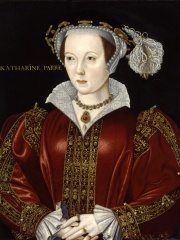
5. Catherine Parr (1512 - 1548)
With an HPI of 79.40, Catherine Parr is the 5th most famous British Companion. Her biography has been translated into 56 different languages.
Catherine Parr (c. July or August 1512 – 5 September 1548) was Queen of England and Ireland as the last of the six wives of King Henry VIII from their marriage on 12 July 1543 until Henry's death on 28 January 1547. Catherine was the final queen consort of the House of Tudor, and outlived Henry by a year and eight months. With four husbands, she is the most-married English queen consort. She was the first woman in England to publish in print an original work under her own name in the English language. Catherine enjoyed a close relationship with Henry's three children, Mary, Elizabeth and Edward. She was personally involved in the education of Elizabeth and Edward. She was influential in Henry's passing of the Third Succession Act in 1543 that restored his daughters Mary and Elizabeth to the line of succession to the throne. Catherine was appointed regent from July to September 1544 while Henry was on a military campaign in France; in the event that he lost his life, she was to rule as regent until Edward came of age. However, he did not give her any function in government in his will. On account of her Protestant sympathies, she provoked the enmity of anti-Protestant officials, who sought to turn the King against her; a warrant for her arrest was drawn up, probably in the spring of 1546. However, she and the king soon reconciled. On 25 April 1544, Catherine published her first book, Psalms or Prayers, anonymously. Her book Prayers or Meditations became the first original book published by an English queen under her own name on 2 June 1545. She published a third book, The Lamentation of a Sinner, on 5 November 1547, nine months after the death of King Henry VIII. After Henry's death on 28 January 1547, Catherine was allowed as queen dowager to keep the queen's jewels and dresses. She assumed the role of guardian to her stepdaughter Elizabeth, and took Henry's great-niece Lady Jane Grey into her household. About six months after Henry's death, she married her fourth and final husband, Thomas Seymour, 1st Baron Seymour of Sudeley. The marriage was short-lived, as she died on 5 September 1548 due to complications of childbirth. Her funeral, held on 7 September 1548, was the first Protestant funeral in England, Scotland or Ireland to be held in English.

6. Jane Seymour (1508 - 1537)
With an HPI of 78.59, Jane Seymour is the 6th most famous British Companion. Her biography has been translated into 60 different languages.
Jane Seymour (; c. 1508 – 24 October 1537) was Queen of England as the third wife of King Henry VIII from their marriage on 30 May 1536 until her death the next year. She became queen following the execution of Henry's second wife, Anne Boleyn, who was accused by Henry of adultery after failing to produce a male heir. Jane, however, died of postnatal complications less than two weeks after the birth of her only child, the future King Edward VI. She was the only wife of Henry VIII to receive a queen's funeral, and Henry was later buried alongside her remains in St George's Chapel, Windsor Castle.

7. Elizabeth Stuart, Queen of Bohemia (1596 - 1662)
With an HPI of 78.24, Elizabeth Stuart, Queen of Bohemia is the 7th most famous British Companion. Her biography has been translated into 46 different languages.
Elizabeth Stuart (19 August 1596 – 13 February 1662) was Electress of the Palatinate and briefly Queen of Bohemia as the wife of Frederick V of the Palatinate. The couple's selection for the crown by the nobles of Bohemia was part of the political and religious turmoil that set off the Thirty Years' War. Since her husband's reign in Bohemia lasted over only one winter, she is called "The Winter Queen" (German: Die Winterkönigin, Czech: Zimní královna). Princess Elizabeth was the only surviving daughter of James VI and I, King of Scotland, England, and Ireland, and his queen, Anne of Denmark; she was the elder sister of Charles I. Born in Scotland, she was named in honour of her father's cousin and predecessor on the English throne, Elizabeth I. During Elizabeth Stuart's childhood, unbeknownst to her, part of the failed Gunpowder Plot was a scheme to replace her father with her on the throne, and forcibly raise her as a Catholic. Her father later arranged for her marriage to the Protestant Frederick V, a senior prince of the Holy Roman Empire. They were married in the Chapel Royal in the Palace of Whitehall, and then left for his lands in Germany. Their marriage proved successful, but after they left Bohemia, they spent years in exile in The Hague, while the Thirty Years' War continued. In her widowhood, she eventually returned to England at the end of her own life during the Stuart Restoration of her nephew and is buried in Westminster Abbey. With the death in 1714 of Elizabeth's great-niece, Anne, Queen of Great Britain, the last Stuart monarch, the British throne passed to her grandson (by her daughter Sophia of Hanover) as George I, initiating the rule of the House of Hanover.

8. Mary Boleyn (1499 - 1543)
With an HPI of 78.19, Mary Boleyn is the 8th most famous British Companion. Her biography has been translated into 45 different languages.
Mary Boleyn (c. 1499 – 19 or 30 July 1543), also known as Lady Mary, was the sister of English queen consort Anne Boleyn, whose family enjoyed considerable influence during the reign of King Henry VIII. Mary was one of the mistresses of Henry VIII for an unknown period. It has been rumoured that she bore two of the King's children, though Henry did not acknowledge either. Mary was also rumoured to have been a mistress of Henry VIII's rival, King Francis I of France, for some period between 1515 and 1519. Mary Boleyn was married twice: in 1520 to William Carey, and again, secretly, in 1534, to William Stafford, a soldier from a good family but with few prospects. This secret marriage to a man considered beneath her station angered King Henry VIII and her sister, Queen Anne, and resulted in Mary's banishment from the royal court. She died seven years later, having spent the remainder of her life in obscurity.

9. Victoria, Princess Royal (1840 - 1901)
With an HPI of 77.93, Victoria, Princess Royal is the 9th most famous British Companion. Her biography has been translated into 50 different languages.
Victoria, Princess Royal (Victoria Adelaide Mary Louisa; 21 November 1840 – 5 August 1901) was German Empress and Queen of Prussia as the wife of Frederick III, German Emperor. She was the eldest child of Queen Victoria of the United Kingdom and Prince Albert of Saxe-Coburg and Gotha and was created Princess Royal in 1841. As the eldest child of the British monarch, she was briefly heir presumptive until the birth of her younger brother, the future Edward VII. She was the mother of Wilhelm II, the last German Emperor. Educated by her father in a politically liberal environment, Victoria was married at the age of 17 to Prince Frederick of Prussia, with whom she had eight children. Victoria shared with Frederick her liberal views and hopes that Prussia and the later German Empire should become a constitutional monarchy, based on the British model. Criticised for this attitude and for her English origins, Victoria suffered ostracism by the Hohenzollerns and the Berlin court. This isolation increased after the rise to power of Otto von Bismarck, one of her staunchest political opponents, in 1862. Victoria was empress for only a few months, during which she had opportunity to influence the policy of the German Empire. Frederick III died in 1888 – 99 days after his accession – from laryngeal cancer and was succeeded by their son Wilhelm II, who had much more conservative views than his parents. After her husband's death, she became widely known as Empress Frederick (German: Kaiserin Friedrich). The empress dowager then settled in Kronberg im Taunus, where she built Friedrichshof, a castle, named in honour of her late husband. Increasingly isolated after the weddings of her younger daughters, she died of breast cancer in August 1901, less than seven months after the death of her mother, Queen Victoria, in January 1901. The correspondence between Victoria and her parents has been preserved almost completely: 3,777 letters from Queen Victoria to her eldest daughter and about 4,000 letters from the empress to her mother are preserved and catalogued. These give a detailed insight into life at the Prussian court between 1858 and 1900.
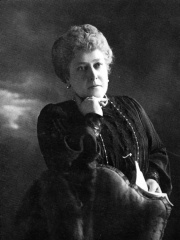
10. Princess Helena of the United Kingdom (1846 - 1923)
With an HPI of 77.31, Princess Helena of the United Kingdom is the 10th most famous British Companion. Her biography has been translated into 37 different languages.
Princess Helena (Helena Augusta Victoria; 25 May 1846 – 9 June 1923), later Princess Christian of Schleswig-Holstein, was the third daughter and fifth child of Queen Victoria and Prince Albert. Helena was educated by private tutors chosen by her father and his close friend and adviser, Baron Stockmar. Her childhood was spent with her parents, travelling between a variety of royal residences in Britain. The intimate atmosphere of the royal court came to an end on 14 December 1861, when her father died and her mother entered a period of intense mourning. Afterwards, in the early 1860s, Helena began a flirtation with Prince Albert's German librarian, Carl Ruland. Although the nature of the relationship is largely unknown, Helena's romantic letters to Ruland survive. After her mother discovered the flirtations, in 1863, she dismissed Ruland, who returned to his native Germany. Three years later, on 5 July 1866, Helena married the impoverished Prince Christian of Schleswig-Holstein. The couple remained in Britain, in calling distance of the queen, who liked to have her daughters nearby. Helena, along with her youngest sister, Princess Beatrice, became the queen's unofficial secretary. However, after Queen Victoria's death on 22 January 1901, Helena saw relatively little of her surviving siblings. Helena was the most active member of the royal family, carrying out an extensive programme of royal engagements. She was also an active patron of charities, and was one of the founding members of the British Red Cross. She was founding president of the Royal School of Needlework, and president of the Workhouse Infirmary Nursing Association and the Royal British Nurses' Association. As president of the latter, she was a strong supporter of nurse registration against the advice of Florence Nightingale. In 1916 she became the first member of her family to celebrate her 50th wedding anniversary, but her husband died a year later. Helena outlived him by six years, dying aged 77 in 1923.
People
Pantheon has 62 people classified as British companions born between 626 and 1988. Of these 62, 5 (8.06%) of them are still alive today. The most famous living British companions include Catherine, Duchess of Cambridge, Mordred, and Sophie, Countess of Wessex. The most famous deceased British companions include Anne Boleyn, Mary of Teck, and Anne Hathaway.
Living British Companions
Go to all RankingsCatherine, Duchess of Cambridge
1982 - Present
HPI: 72.82
Mordred
HPI: 71.49
Sophie, Countess of Wessex
1965 - Present
HPI: 70.91
Marie-Chantal, Crown Princess of Greece
1968 - Present
HPI: 60.10
Carrie Johnson
1988 - Present
HPI: 48.40
Deceased British Companions
Go to all RankingsAnne Boleyn
1501 - 1536
HPI: 86.36
Mary of Teck
1867 - 1953
HPI: 83.82
Anne Hathaway
1556 - 1623
HPI: 80.60
Maud of Wales
1869 - 1938
HPI: 79.92
Catherine Parr
1512 - 1548
HPI: 79.40
Jane Seymour
1508 - 1537
HPI: 78.59
Elizabeth Stuart, Queen of Bohemia
1596 - 1662
HPI: 78.24
Mary Boleyn
1499 - 1543
HPI: 78.19
Victoria, Princess Royal
1840 - 1901
HPI: 77.93
Princess Helena of the United Kingdom
1846 - 1923
HPI: 77.31
Catherine Howard
1523 - 1542
HPI: 77.14
Elizabeth of York
1466 - 1503
HPI: 76.11
Overlapping Lives
Which Companions were alive at the same time? This visualization shows the lifespans of the 24 most globally memorable Companions since 1700.

